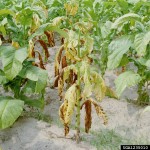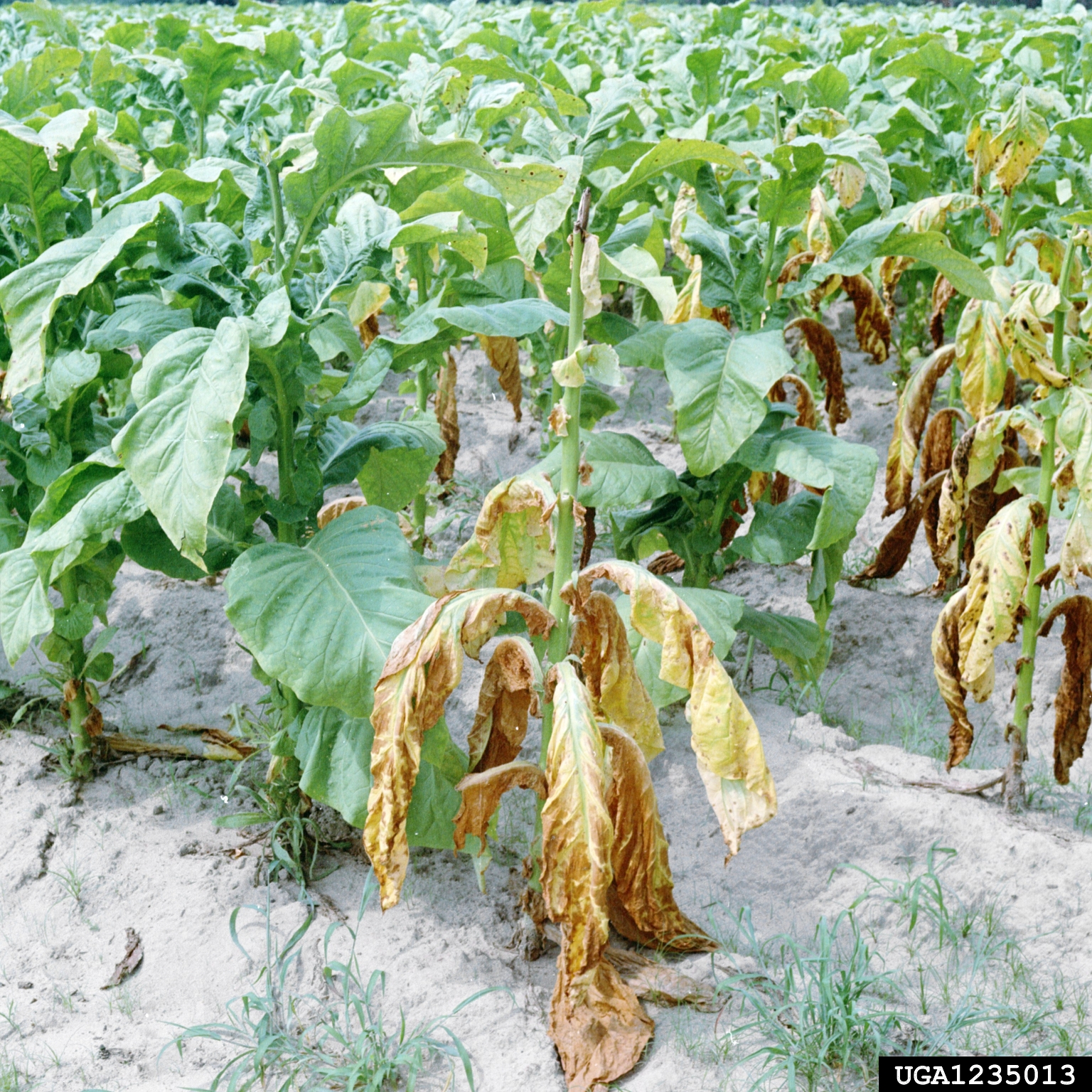Black Shank
Varieties Resistant to Bacterial Wilt: CC 27, CC 37, CC 67, CC 143, NC 299, SP 227, SP 236

Click for larger |

Click for larger |

Click for larger |
Pictures provided by Clemson University – USDA Cooperative Extension Slide Series, Bugwood.org
Black shank is among the most destructive and widespread of all tobacco diseases. This disease is most prevalent in poorly-drained areas where tobacco was planted the previous year. Black shank is a warm-weather disease, which is favored by temperatures ranging from about 84 to 90 F. Once soil in a field becomes infested with the black shank fungus, it cannot be eliminated, therefore, the disease must be managed every year on a continuing basis.
The disease is characterized by a rapid yellowing and wilting followed by death of the entire plant. A dark brown to black, somewhat sunken, lesion usually appears on the stalk at or near the ground level. This lesion often extends up the stalk or shank of the plant causing it to turn black. Stalks, when split, usually reveal the blackened pith separated into discrete disks. This feature is of diagnostic value only when used in conjunction with other observations because disking may occur due to other factors. Infected plants may be scattered or uniformly distributed in a given field. Roots and crowns are usually decayed. Only root and crown symptoms may be observed in very dry years or on resistant varieties.
Black shank is caused by the fungus Phytophthora parasitica var. nicotiana which lives in the soil. This pathogen belongs to a group of fungi that occurs commonly in areas of high soil moisture. The fungus produces microscopic spores which swim in water surrounding roots and/or soil particles. These swimming spores are attracted to tobacco, their only natural host, by root exudates produced primarily at growing points and wounds. Whereas wounds are not required for penetration, they do favor more rapid disease build-up.
When the soil environment is not suitable for protection and survival of the motile spores, the fungus forms thick-walled, resistant spores some of which may survive for years during conditions unfavorable for the fungus. Once conditions are favorable, the resistant spores germinate and motile spores are produced. During favorable conditions for the fungus, a new generation of motile spores is produced every 72 hours.
The black shank fungus is spread when infested soil is moved from one place to another. Contaminated irrigation or runoff water may also aid in its movement within a field or from one field to another.
Although roots are the most commonly affected plant parts, occasionally the fungus infects leaves and forms circular, yellowish-to-brown lesions up to 3 inches in diameter. Leaf infection may occur as a result of zoospores in splashing water or contact with infested soil.
There are two known types of black shank, race 0 and race 1, and they are easily confused.
Crop Rotation – Rotation should be the foundation of any black shank management program because the fungus attacks only tobacco. Leaving the field out of tobacco for one or more years will reduce, but not eliminate, this fungus. Any crop can be grown between tobacco crops to reduce the population level of the pathogen.
Resistant Varieties – Varieties possessing various levels of resistance to black shank are available; however, they should be used as part of an integrated approach including crop rotation and other appropriate cultural practices. The latest issue of the Flue-Cured Tobacco Information bulletin lists varieties and their resistance levels. This bulletin is available in all county extension centers.
Chemical Control – Several soil-applied chemicals are labeled for black shank control. Included are the multi-purpose fumigants Telone C-17, Chlor-O-Pic 100, and Terr-O-Gas 67. However, the systemic fungicides Ridomil Gold or Ultraflourish are the most effective materials against black shank. Additional information on chemical control can be obtained from the most recent Flue-Cured Tobacco Information bulletin.
Drainage – Improving drainage in poorly drained areas reduces black shank losses by making the soil environment less favorable for infection.
Sanitation – Elimination of the host by destroying stalks and roots immediately following harvest will help reduce populations of the fungus and nematodes, resulting in less damage in the next crop.
Nematode Control – Control of root-knot nematodes helps to ensure the effectiveness of resistant varieties and fungicides. In fields infested with both the black shank fungus and root-knot nematodes, the effectiveness of black shank resistant varieties and fungicides is reduced if the nematodes are not controlled.